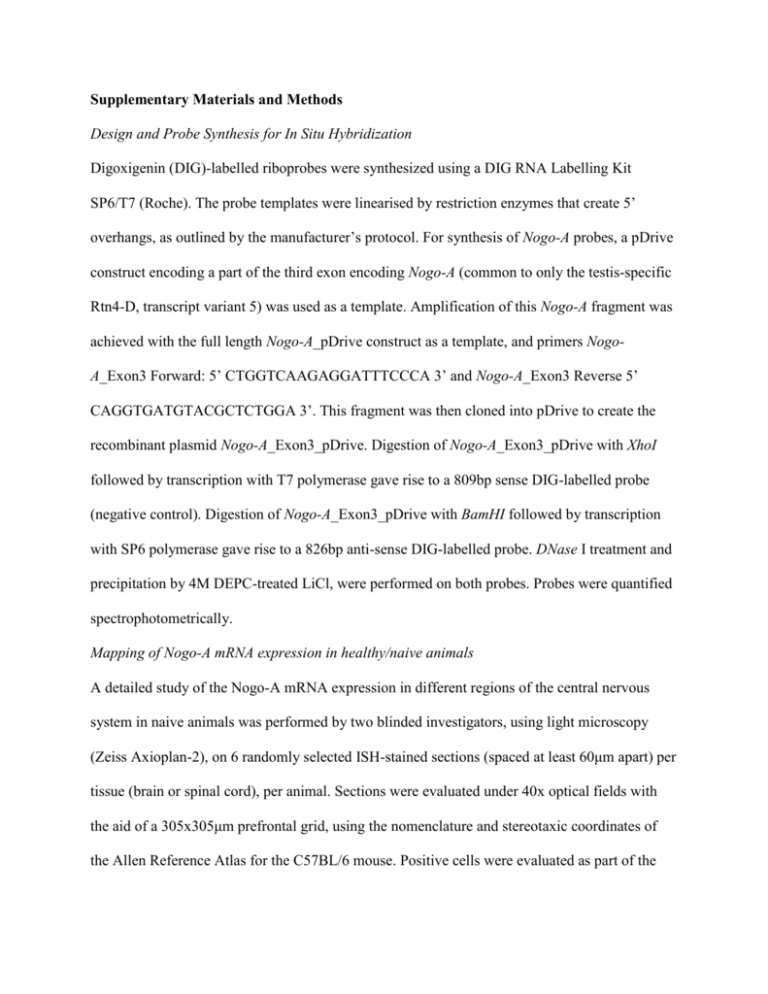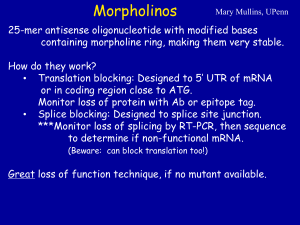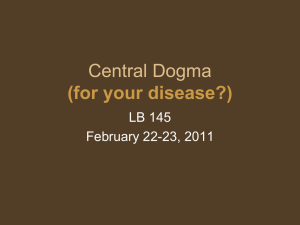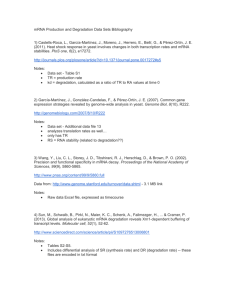Supplementary Material and Methods
advertisement

Supplementary Materials and Methods Design and Probe Synthesis for In Situ Hybridization Digoxigenin (DIG)-labelled riboprobes were synthesized using a DIG RNA Labelling Kit SP6/T7 (Roche). The probe templates were linearised by restriction enzymes that create 5’ overhangs, as outlined by the manufacturer’s protocol. For synthesis of Nogo-A probes, a pDrive construct encoding a part of the third exon encoding Nogo-A (common to only the testis-specific Rtn4-D, transcript variant 5) was used as a template. Amplification of this Nogo-A fragment was achieved with the full length Nogo-A_pDrive construct as a template, and primers NogoA_Exon3 Forward: 5’ CTGGTCAAGAGGATTTCCCA 3’ and Nogo-A_Exon3 Reverse 5’ CAGGTGATGTACGCTCTGGA 3’. This fragment was then cloned into pDrive to create the recombinant plasmid Nogo-A_Exon3_pDrive. Digestion of Nogo-A_Exon3_pDrive with XhoI followed by transcription with T7 polymerase gave rise to a 809bp sense DIG-labelled probe (negative control). Digestion of Nogo-A_Exon3_pDrive with BamHI followed by transcription with SP6 polymerase gave rise to a 826bp anti-sense DIG-labelled probe. DNase I treatment and precipitation by 4M DEPC-treated LiCl, were performed on both probes. Probes were quantified spectrophotometrically. Mapping of Nogo-A mRNA expression in healthy/naive animals A detailed study of the Nogo-A mRNA expression in different regions of the central nervous system in naive animals was performed by two blinded investigators, using light microscopy (Zeiss Axioplan-2), on 6 randomly selected ISH-stained sections (spaced at least 60μm apart) per tissue (brain or spinal cord), per animal. Sections were evaluated under 40x optical fields with the aid of a 305x305μm prefrontal grid, using the nomenclature and stereotaxic coordinates of the Allen Reference Atlas for the C57BL/6 mouse. Positive cells were evaluated as part of the total cells in each separate CNS structure using a semiquantitative scale: 0 = no signal (or 1-3 sparse Nogo-A positive cells), + = mild expression or few scattered Nogo-A positive cells, ++ = moderate intensity of Nogo-A expression, +++ = strong and almost ubiquitous Nogo-A cellular expression. This semiquantitative methodology was based on the one of Hasegawa et al. 2005, which was applied for the rat (Hasegawa T et al, 2005). Real-time PCR Nogo-A, NGR and GAP 43 semi-quantitative real-time PCR, was performed in total RNAs extracted from brain and spinal cord tissues using Trizol reagent (Invitrogen), RNA was reverse transcribed to cDNA with Iscript cDNA Synthesis Kit (Biorad) and real-time PCR was performed using Biorad IQ5 ICycler Multicolor Detection System. The relative gene expression was normalized to b-actin which served as an internal control. Reactions were performed using the 2x Master Mix SYBR (Biorad). The reaction included 10 μl of the master mix, 0,4 μl of each primer (10pmol), 1 μl of cDNA and nuclease free water up to 20 μl. PCR conditions were 95 o C for 10 min, followed by 40 cycles of 94 o C for 30 seconds, 60 o C for 30 sec and 72 o C for 30 sec, and a final step of 72 o C for 5 min. The analysis of the melting curve of each amplified PCR product allowed to control the specificity of the amplification. Primer sequences for SYBR Green probes of target genes area follows: Nogo-A (Rtn4): Forward 5' AGAGTCACCTGCGACCCTTA 3' and Reverse 5' TAGCTCTAGCAGCCAGCACA 3' giving rise to a 203bp product; Nogo Receptor (Rtn4r): Forward 5' CATGGCAACCGTATCCCCAG 3' and Reverse 5' GCATTAGGACCTCTGCAGGC 3' giving rise to a 187 bp product; Growth Associated Protein 43 (GAP-43): Forward 5' ATAACTCCCCGTCCTCCAAG 3' and Reverse 5' CAGCGTCTTTCTCCTCCTCA 3' giving rise to a 186 bp product; β-actin (Actb): Forward 5' TTGTAACCAACTGGGACGATATGC 3' and Reverse 5' GATCTTGATCTTCATGATGCTAGG 3' giving rise to a 139 bp product. The results were analyzed using ΔΔCt method. Western Blot analysis (Immunoblotting) Brain and spinal cord tissue were homogenized, separated with SDS-PAGE and transferred onto PVDF membranes. Proteins were detected with anti-Nogo-A (Santa Cruz, California 1:500) and anti-NgR antibody (Santa Cruz, California, 1:500). Anti-actin beta antibody (abcam 1:5000) was used as loading control. Immunoreactive bands were visualized using HRP-conjugated goat antirabbit IgG antibody (Pierce, 1:10000) followed by chemiluminescence (LumiSensor Plus Chemiluminescent HRP Substrate kit, GenScript). Results were analyzed with densitometry using ImageJ. Supplementary Results Expression of Nogo-A mRNA in healthy/naive animals Several areas were found to express Nogo-A abundantly and some representative ones are depicted in Figure 2 (A1, B1, C1, D1). In particular, Nogo-A mRNA was abundantly expressed in the olfactory bulb, displaying the strongest signal in the mitral and granular cell layers (Fig. 2A1). Cerebral cortex exhibited an affluent - yet diffuse - expression of Nogo-A mRNA with a relatively higher level in layers II/III and IV/V. In diencephalic structures such as hypothalamus and thalamus, Nogo-A mRNA exhibited a moderate to strong expression, with specific thalamic nuclei such as anterodorsal, paraventricular and nucleus of reunions exhibiting the highest levels. A strong signal was detected in the piriform cortex, while a profuse Nogo-A mRNA expression was also observed in hippocampal formation, especially in CA3 pyramidal neurons and the hilus of dentate gyrus (Fig. 2B1). Nogo-A mRNA was abundantly expressed in the habenular structure exhibiting a very strong signal in the medial nucleus. Brainstem areas generally exhibited a mild and scattered Nogo-A mRNA expression pattern, with the exception of specific regions that have been referred to exhibit a strong expression signal, such as the red and the occulomotor nucleus (1) and the locus ceruleus, a structure that has also been previously reported to abundantly express Nogo-A mRNA in rat (2). Cerebellar Nogo-A mRNA expression was mainly located in Purkinje cells and a sparse signal in the layer of granular cells (Fig. 2C1). Cells in both gray and white matter of the spinal cord expressed Nogo-A mRNA. In gray matter, signal was observed in scattered large motor neurons of the ventral horn, whereas there was a notable expression in the dorsal horn as well (Fig. 2D1). In white matter, a very weak signal was detected in small gliallike cells, most likely representing oligodendrocytes. References 1. Josephson A, Widenfalk J, Widmer HW, Olson L, Spenger C. NOGO mRNA expression in adult and fetal human and rat nervous tissue and in weight drop injury. Exp Neurol 2001:169;319-28. 2. Hasegawa T, Ohno K, Sano M, Omura T, Omura K, Nagano A, Sato K. The differential expression patterns of messenger RNAs encoding Nogo-A and Nogo-receptor in the rat central nervous system. Brain Res Mol Brain Res 2005:133;119-30. 3. Hunt D, Coffin RS, Prinjha RK, Campbell G, Anderson PN. Nogo-A expression in the intact and injured nervous system. Mol Cell Neurosci 2003:24;1083-102.









